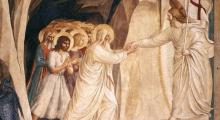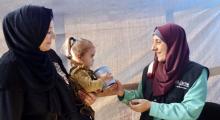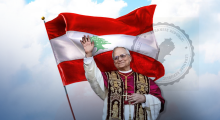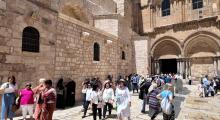Issued by the Catholic Center for Studies and Media - Jordan. Editor-in-chief Fr. Rif'at Bader - موقع أبونا abouna.org
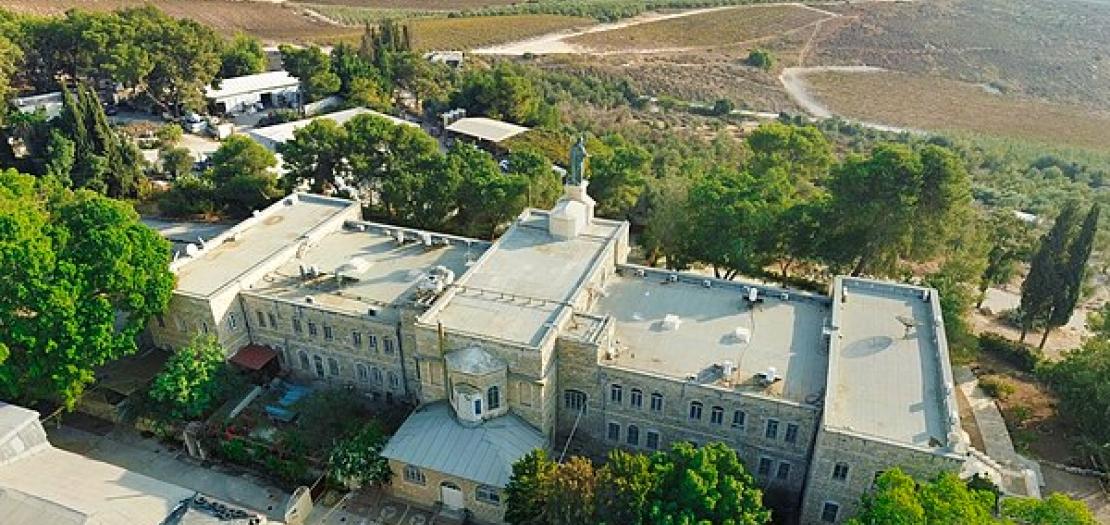
Celebrated on October 25 every year according to the liturgical calendar, the feast of the Blessed Virgin Mary, Queen of Palestine, brings together thousands of faithful each year at the shrine dedicated to Her, in Deir Rafat.
Founded by Patriarch Luigi Barlassina in the 1920s, this place of pilgrimage is very important to Palestinian Christians and the whole diocese of the Holy Land.
On 15th July 1920, the brand-new Patriarch of Jerusalem, the Italian Luigi Barlassina, made his solemn entry into the Basilica of the Holy Sepulchre. On this occasion, hedecided to place Palestine under the patronage of the mother of God, true sovereign of this land that the growing tensions between Arabs and Jews were slowly beginning to tear apart. These tensions would subsequently lead to the 1929 riots, then to the Arab Revolt from 1936-1939. “We beseech thee to turn a pitying glance upon Palestine, which more than any other country belongs to thee, since thou hast graced it with thy birth, thy virtues and thy sorrows. Deign to watch, therefore, with special protection over thy native country, scatter from it the shades of error, for it was there the Sun of Eternal Justice shone,” implores Msgr. Barlassina in a prayer that he himself composed and dedicated to the “Queen of Palestine”.
A shrine for the “Queen of Palestine”
The Patriarch decided to give more concrete expression to this patronage by erecting a shrine where the Virgin Mary could be honoured by the faithful of the diocese of the Holy Land, under the title of “Queen of Palestine”. The choice of location was Deir Rafat, halfway between Tel Aviv and Jerusalem, a region where the Holy Scriptures place some of the exploits of Samson, the last Judge of ancient Israel (Judges 13-16). The construction of the church, designed by Maurizio Gisler (1855-1940), Benedictine of the Dormition Abbey, began in 1925; it was completed in 1927 and inaugurated the following year by Bishop Barlassina himself.
The ceiling of the building, as well as parts of the walls, were decorated by a Palestinian artist who, at the request of the Patriarch, included the famous greeting of the Archangel Gabriel to the Virgin of Nazareth – “Hail, Mary” - in 280 languages. To the left of the nave, there is a painting by a Franciscan nun, representing the mother of Christ blessing the Holy Land, from Mount Carmel to Jerusalem, while two angels present her with the sceptre and crown, symbols of her royalty.
From then on, the Queen of Palestine was celebrated on the last Sunday of October; this solemnity was then approved in 1933 by Pope Pius XI. Mgr. Barlassina asked that the 1920 supplication be recited regularly in the parishes and religious communities of the Holy Land, the aim being to spread the devotion as widely as possible.
Roses from the Knights
It acquired international influence from the moment when, by the decree “Est quidem notum” of Saint Pope John Paul II (21st January 1994), the “Regina Palestinae” was proclaimed patroness of the Order of the Holy Sepulchre. In actual fact, the Knights’ and Dames’ attachment to their Queen goes back to the very origins of the devotion – the Order was instrumental in financing a large part of the construction of the sanctuary. One particular story illustrates this well. It is the year 1934. Two Italian Knights, Giuseppe Folonari from Brescia, and Roberto Malinverni from Turin, decide to make a pilgrimage to the Holy Land. Having left Milan aboard a private plane, they land at the military airport of Ramleh, after a journey of 5,000 km. Once they have completed their visit to the Holy Places, the two men get back on board their aircraft, but do not want to return to Italy without going through Deir Rafat. The small plane takes off from Ramleh and flies over the sanctuary until it is just skimming the roof. And now Folonari, opening the door of the aircraft, throws out the bouquet of roses that he and his companion have brought with them. “An indescribable emotion flooded into our hearts,” he later recounted. The tribute to the Queen has been paid: the Knights can go home!
The image and the prayer, translated into several languages, gradually crossed the borders of the diocese of the Holy Land... and came to Poland, to Praszka, in the archdiocese of Czestochowa, where a small sanctuary, founded by a pious Polish Knight of the Holy Sepulchre, is consecrated to Our Lady of Palestine.
Deir Rafat and Palestinian Christians
It is to be expected that two-thousand-year-old Places of Redemption – Nazareth, Bethlehem or Jerusalem – attract many more pilgrims than a sanctuary built less than a century ago. However, the Christians of Israel and Palestine “know Deir Rafat and love going there to venerate their patron saint, to ask her for her protection for their families and especially for the Holy Land," observes Mgr. William Shomali, Patriarchal Vicar for Jerusalem and Palestine. Many of them congregate at the sanctuary on the last Sunday in October. Many of them, however, need a special permit to participate in this celebratory and unifying event; “The Latin Patriarchate manages to obtain about a thousand each year,” says Bishop Shomali.
In addition to this annual feast, the “national” shrine has also hosted several of the significant events in the history of the diocese. The patriarchal vicar recalls two of them, in particular: the consecration of the whole Holy Land to the Virgin Mary, which was “a moment of great ecclesial communion” (on 31st October 2010, i.e., one week after the closing of the Synod of Bishops for the Middle East) and the opening of the synodal process requested by Pope Francis (30th October 2021) in the presence of 2,000 faithful.
It was in Deir Rafat that Mgr. Giacomo Beltritti, Latin Patriarch of Jerusalem from 1970 to 1987, asked to retire after having resigned his position, for reasons of age. “A man of faith, he wanted to dedicate the rest of his life to prayer and meditation in the shadows of the sanctuary of Our Lady of Palestine”, welcoming pilgrims, teaching catechism to children and celebrating mass for the nuns there, says Mgr. Shomali. It should not be forgotten that it is the ancillary activities of the sanctuary which have contributed to its popularity.
The nuns of Bethlehem, a presence of prayer at the sanctuary
In 1928, Deir Rafat was entrusted to the custody of the Sisters of Saint Dorothea; until 1948, they also took charge of the orphanage and the vocational school installed in the buildings adjoining the church – where the Latin Patriarchate’ first printing press was also located. From 1975, the same congregation ran an elementary school for children of families in difficulty; after its closure in 2006, the sisters of Saint Dorothea left the sanctuary.
In 2009, Patriarch Fouad Twal asked the nuns from the Monastic Family of Bethlehem to ensure a presence of prayer and adoration there. “We remain there, in silence and prayer, bringing before God the pilgrims who come to pray in this blessed place”, testifies one of them. In this “universal” place, where it is also possible to go on silent retreat, “everyone feels at home”, she continues, remembering especially a group of pilgrims who came to the church to pray. Each of them tried to find their native language among the 280 painted on the ceiling. It was then that “a little old man started to cry, because he had just found “his” language, Armenian… His country was there, under the protection of the Queen”. Stories like this are legion.
The Marian shrine welcomes Christians of all denominations, but also Jews and Muslims. What are they looking for there? “A place of peace; a place to pray; a place or a time, where one feels safe, where one is accepted for who one is, a person to love; they come to seek a testimony of Faith there,” come the answers from the nuns of Bethlehem. Christians, Jews and Muslims rub shoulders at the feet of the Queen of Palestine, to place there the same desires and the same prayers: for peace of heart, peace in families and peace for this beautiful land of Lord Jesus.


